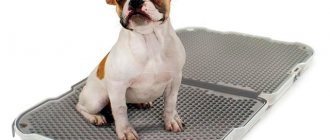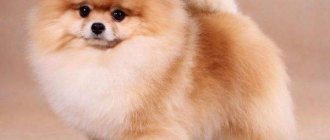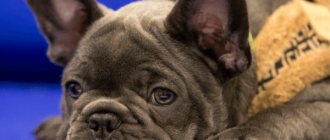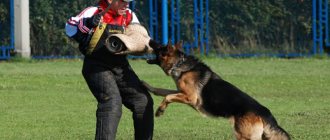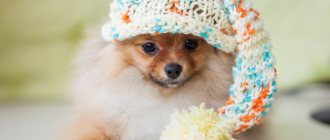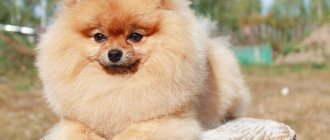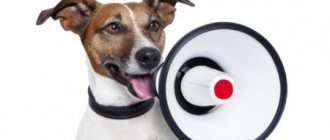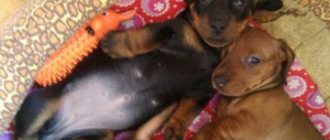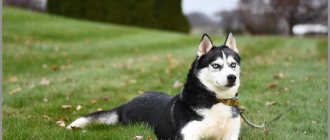Once upon a time, even before the revolution, at the very beginning of the last century, this breed was very popular in Russia, especially among people of high society, and among its representatives were such celebrities as F.I. Chaliapin, B.M. Kustodiev, V.V. Mayakovsky. A rather cute French bulldog named Ortino belonged to Grand Duchess Tatyana Nikolaevna, the second daughter of our last autocrat; this devoted dog went into exile with the entire royal family, first to Tobolsk, and then to Yekaterinburg, where he stayed with the entire family until their very last days. His further fate is unknown for certain, however, a number of sources say that he died along with everyone else during the execution of members of the royal family and their immediate circle.
This is probably why, due to their enormous popularity in Tsarist Russia, with the advent of Soviet power, French bulldogs found themselves under an unspoken ban in the USSR, appearing here again only after the end of the Great Patriotic War.
French Bulldog: description of the breed
Medium size, proportionally built, muscular, literally athletic in shape, very hardy short-haired dog. According to the classification of the International Canine Federation (FCF), dogs of this breed belong to the group of decorative breeds and companion dogs.
general characteristics
In the most general terms,
- from a French bulldog a guard or watchman is like a bullet from an Aries,
- because French bulldogs and aggression are in most cases completely incompatible concepts;
- The daily physical activity of French Bulldogs is rather low:
- French bulldogs, if they can be trained, do so with great reluctance and laziness a la Prince de Lazy;
- French bulldogs have slightly above average intelligence, and so on and so forth.
Height
French bulldogs, like all other domestic dog breeds and wild canines in general, are characterized by dimorphism - their males are always larger than their females.
The average height of an adult male, male, is 27 – 35 cm with slight variations within one centimeter in one direction or another; The height of an adult female, bitch, is 24–32 cm at the withers with the same minor variations in both directions – both upward and, conversely, downward.
By the way, the growth of French bulldogs is in no way limited by standards. Although, in general, it’s already clear that the size of the legendary Hound of the Baskervilles is the same as for us from here to Beijing in the knee-elbow position.
Weight
The same dimorphism is manifested in the average weight of French bulldog individuals: males weigh 9 – 14 kg, plus or minus half a kilo; and their bitches – 13 kg, also plus or minus half a kilo. At the same time, females are visually lighter in build and more graceful than males.
So these dogs can rightfully be called compact.
Lifespan
It is interesting that French bulldog girls live slightly longer than their boys - the average life expectancy is thus up to 15 years in the first case, and about 12 years in the second.
It is believed that such a difference in the life expectancy of individuals of both sexes is due to the difference in their character - girls are calmer, which certainly cannot be said about boys.
It is clear that the more carefully the owner takes care of the pet, the longer it lives.
Basic rules of mating
The process of breeding French bulldogs is quite complicated, and the best advice is to invite people like breeders to help you in this matter. There are several rules that every specialist will advise you in any case. Mating, for a positive result, should be repeated twice, preferably within 1 day. It is best if mating occurs on the territory of the male. Before mating, protect the dog from stress, otherwise the dogs will worry, which will not lead to anything good. Don't be nervous, if the landing is unsuccessful, your anxiety will be passed on to the dogs.
The fertility of a dog is hereditary, which means it is absolutely independent of the male. For male French bulldogs, mating is possible at any age, even old, but you should not expect healthy and strong offspring from such males. The best time for mating is the end of the second week, after the start of estrus. If the bitch is ready for mating, you can run your hand over the croup and lower back; she should bend her paws, as if sitting down, but without touching the ground with her backside. Before mating, it is best to walk and feed dogs, however, at least 3 hours should pass from eating to introduction and the moment when mating occurs. Before mating, it is advisable to wash the bitch’s genitals with a solution of rivanol to disinfect. Depending on the nature of the dogs, the cable can either immediately begin to mount, or first flirt with her.
French bulldog standard: Height at the withers - 25-35 cm, weight 8-14 kg. Color: brindle, fawn, white-fawn (with spots), cream and white. Coat: short, smooth, shiny.
Pros He enjoys the company of people
Difficulties To avoid diaper rash, it is necessary to lubricate the folds on the face with naphthalene ointment (zinc ointment is possible. - Ed.) Snores:)
History of the French Bulldog breed
Oddly enough, French bulldogs were bred on the shores of Foggy Albion, in England. And the first to become interested in this breed and its capabilities were the local... seamstresses, who found these dogs quite suitable for keeping them as pets and part-time rat catchers.
For some reason unknown to us, these seamstresses went, as they would say now, for permanent residence in France and, of course, brought their favorites with them, where they began to catch the eye of the French elite. And the rest was only a matter of time - the future French bulldog became extremely popular in the very top strata of French society, which, naturally, could not but affect the cost of these dogs.
And some time later, the French got involved, registered a new breed and called it their own, the French bulldog.
French bulldogs appeared in Russia at the very beginning of the 20th century.
The history of the appearance of the French
The French Bulldog is a relatively young breed. It began to be introduced only towards the end of the nineteenth century. If we put together all the information about the breed, then, according to many experts, the ancestors of the Frenchman are English bulldogs, Spanish Alans and pugs. Perhaps this explains the external similarity of the listed breeds.
Previously, people used bulldogs for their own entertainment and organized dog fights. After all, the breed was considered a fighting breed. Even the name “bulldog” literally means “bull dog”, “bull dog”. Sometimes dogs were allowed to fight a bull (a kind of bullfight). But, fortunately, very soon such cruelty was banned, and bulldogs began to be perceived by people as domestic dogs. It is in France that the fighting dog is made into a domestic dog.
Now the French are popular literally everywhere. This funny French dog with huge ears is so friendly and sweet that it’s hard to imagine her in the fighting ring.
What does a French bulldog look like?
“Well tailored, tightly sewn” from Tvardovsky’s famous poem - this is also about him, about a baby French bulldog, a cute, funny dog with big eyes and an always upset grimace on his face.
Head
Large, wide and square, clearly not very proportional to the body.
Muzzle
The forehead of a French bulldog is, if you like, its “signature” business card; it is completely covered with characteristic wrinkles, smoothly flowing into symmetrical folds closer to the center. The nose is rather absurd - flattened and upturned, small.
Eyes
The eyes are large, widely spaced; The exceptional goodwill of this extraordinary dog can always be read in them.
Ears
To match the head - large, erect, rounded at the ends.
Torso
This is precisely, and above all, precisely about the body of the French bulldog - “well-cut, tightly sewn”: it is characterized by connoisseurs and lovers of the breed as square, powerful, with a muscular back.
Tail
A separate topic: it can be either a “corkscrew” or a straight one, depending on the structure of the vertebrae that form it. French bulldogs are born with short tails. Another thing is important - the lower it is set, the better, these are the standards of this breed. A docked tail or no tail at all is considered a disqualifying fault.
Forelegs
The forelimbs, although not much, are still shorter than the forelimbs, they are straight and powerful.
Hind limbs
Slightly longer than the front ones, which makes the dog's croup somewhat raised. No less strong and muscular than the front ones.
Wool
It is described by breed standards as smooth and shiny, thin and remains so until a certain age. The hairline fits tightly to the body and has no undercoat, which means only one thing - in dank, cold, and especially frosty weather, before walking on the street, the French bulldog should be insulated by dressing it, for example, in a special overalls.
The coat of a French bulldog, along with some other external signs, is an indicator of its age - when the dog reaches the age of eight and passes this milestone, its coat noticeably becomes dull, and gray hair may appear on the pet’s face.
Breed standard
The French bulldog breed standard includes:
- massive size of the head, on which symmetrical folds and wrinkles are clearly visible. There is a characteristic groove above the eyebrows. On the back of the head you can feel a bump that is weakly defined. The frontal part clearly passes into the muzzle;
- the bones of the upper jaw and nose are shortened, and the lobe and back of the nose are slightly tilted back. The French Bulldog's muzzle ends with a black, wide, slightly snub-nosed lobe. It must be remembered that this structure of the muzzle is often the cause of problems with the respiratory system of this breed of dog;
- the lips are black in color, quite fleshy and hang slightly. When they close in the middle, they completely cover the teeth. The lower and upper jaws are massive, usually the lower one is protruded forward;
- The shape of the eyes is round, large eyes are surrounded by a dark edging and iris. Their expression is a little sad and smart;
- The ears are small in size, thin, widening towards the base, the ends are slightly rounded. They are set high, the distance between them is quite large;
- The neck is small in size, the muscles are clearly visible on it. Dogs of this breed are characterized by a curved neck and no dewlap;
- The body of these dogs is characterized by a gradual rise from the withers to the lumbar region. This feature is manifested in both males and females of the breed;
- the back is powerful, its muscles are well developed, it smoothly passes into a small lumbar region, and then into a sloping croup;
- the shape of the chest is cylindrical, the ribs are curved, so the chest of French bulldogs seems like a barrel, the depth is average;
- The belly of these pets is tucked up, its shape is smooth, and does not have sharp transitions. The tail is small, but covers the anus. It is straight, set low, tapering to the tip;
- the front legs are with short forearms, the pasterns are set vertically. The paws are similar to a cat's, as they are oval in shape, small, the claws are closed together, black in color, set vertically, as they are characterized by the presence of an instep. On its small paws, this pet moves confidently and leisurely.
The following colors of French bulldogs are acceptable:
- shades from fawn to red, possible presence of brindle, white spots (or without them);
- light-colored coats have dark tiger stripes, and there may be a mask on the muzzle;
- solid colors - from fawn to red. The advantage of this coloring is the presence of a mask (but not necessary);
- coloration in which there are spots of white color;
- the fur is brindle in color, and there are white spots all over the body;
- the fur is fawn with a light tint or red, the main advantage is the presence of white spots.
Individuals whose fur is completely white are not considered culled unless they have dark-colored rims around the eyes and a nose of the same color. However, bulldogs with this coloring are not used for further breeding, since the offspring may be born deaf.
Photo of a French bulldog
Photos of adult dogs
Photos of puppies
Character
The character of the French Bulldog is what underlies its endless popularity. These dogs are distinguished by their “increased” friendliness, childish playfulness throughout their lives, the most sincere love for all members of their family, from whom, of course, the French bulldog expects exactly the same thing - love, affection and care, and that everyone there was time to play and have fun with him.
This dog is an ideal companion for people of all ages; it senses the owner’s mood well and will not particularly annoy him if he sees that the person is feeling bad and is not at all interested in her, but will simply settle down calmly and sit somewhere nearby.
At the same time, a French bulldog and loneliness, especially long-term, are incompatible concepts. Prolonged loneliness, the absence of family members at home for a long time, makes this dog a real monster, extremely aggressive, wayward and uncontrollable.
Breeders' advice
Choosing a French bulldog puppy is quite difficult for a non-professional, which is due to many breed characteristics of such a dog . The puppy's nose should be moist and black, but spotting is also allowed, which should completely disappear after five months. A completely healthy dog has a clean and free anal area.
When examining a puppy, be sure to look into its mouth. The teeth should not only be strong, but also even, with a characteristic overbite of the breed. Male dogs must be tested for cryptorchidism, and puppies at one and a half months old must have both testicles descended into the scrotum. You should also pay attention to the behavioral characteristics of the puppy. He should be active and non-cowardly, but not at all aggressive.
Return to content
Education and training
The socialization and training of French bulldogs should be given special attention, since, while getting along quite well with other animals in the house, especially if they do not “strain” it too much, they can and will certainly conflict with their own kind and, even more so, with cats outside it , on the street.
Although these dogs, as already mentioned, are not very willing to be trained, experts strongly recommend doing it from the very moment the baby appears in the house: accustoming him to the tray and a short set of basic restraining commands like “Come to me!”, “You can’t!”, "Sit!" and so on.
Until the age of eight months, French bulldogs literally test the owner’s strength, and here it’s who will win, who will ultimately remain the leader; In this difficult time for both, you should under no circumstances raise your voice at the dog or, especially, beat it.
At the same time, the dog, step by step, is gradually taught to care for it and to observe basic rules of personal hygiene.
Training at home
Theoretical basis
The most important rule that both the owner and his pet, the French bulldog, must learn: the rules of behavior are established once and for all, and any compliance or non-compliance must result in consequences in the form of the owner’s reaction, and immediately (no later than 15 seconds).
Otherwise, such an intelligent dog like a French bulldog will “give” itself permission to interpret the results of its actions at its own discretion, and the educational effect of training may come to naught.
Another important rule is that the owner must be firm and strictly follow the established rules, just like the pet he is training, since even a one-time violation of them, for example in the form of feeding from the table, will give the dog a reason to hope for repetition and the owner risks ending up with an eternal whining and asking for a handout from a bulldog's table.
The next rule that should never be forgotten: perseverance and patience should be the trainer’s flag from the very beginning of raising an animal. The fact is that no matter how smart a dog of this breed is, he will not do what is required of him immediately, for example, after one repetition, and sometimes he will have to wait a long time for the result of the work done.
But water wears away stone, and repetition is the mother of learning, therefore, armed with these folk tenets, patience and treats, the owner will be able to achieve the desired results from his four-legged pupil.
We take into account character and other features
The character of each dog is formed from the moment of birth and can be adjusted by the owner when raising the puppy . The character traits inherent in the French Bulldog must be taken into account in the training plan.
Indeed, according to their temperamental properties, dogs can be both self-confident and shy, fearful, have dominant characteristics or, on the contrary, be very obedient; also, some can bravely and fearlessly rush at other dogs due to a low pain threshold, while other dogs can whine from unsuccessful games with the owner due to a low pain threshold.
This set of character traits can be combined in each dog in different interpretations and with varying degrees of expression, which ultimately makes up a specific picture.
This is interesting! An owner who has determined the type of character of his pet and clearly understands the range of behavioral and other inherent properties of the dog can use these nuances with great success in the training process to achieve maximum results.
It is also necessary to take into account the properties inherent in this breed, since they have been formed over many years, and, in fact, for this purpose the dogs were selected and raised by breeders. So, knowing that French bulldogs are friendly and intended to be kept indoors, it is difficult and almost impossible to require from them the skills of a watchdog living in a booth outside.
But such a dog will not mind lounging on the sofa, so it will be more pleasant for him to carry out the “Place” command if the place is a soft sofa designed specifically for him.
The behavior of a puppy that seems “inappropriate” to the owner is not always what it is . It is sometimes difficult for a non-specialist to distinguish and differentiate non-canine behavior from ordinary canine behaviors that are characteristic of the entire breed or a specific dog. It is possible that the dog often exhibits instinctive behavior at a time when conscious behavior is required of it. After all, a dog is a dog when it combines both of these behavioral types.
The owner must supervise his pet, not leaving his training to chance or delegating these responsibilities to other people who do not have sufficient knowledge. Provided, of course, that the owner wants to have an “unspoiled” friend. After all, it’s better to do everything right from the very beginning than to correct the flaws of a puppy’s problematic behavior.
Preparatory initial stage
Before proceeding directly to training, it is necessary to understand that the full development of a dog includes three elements: its socialization - its relationship with the outside world; education - knowledge and skills that a puppy can acquire by communicating with the outside world, with the help of the owner; training - teaching commands or actions that the owner requires the pet to perform.
It is also important to take into account that the absence or inadequate development of the first elements will certainly complicate the task of developing subsequent ones. Thus, a withdrawn dog that is afraid of communicating with the outside world will show less enthusiasm for learning something new and for learning in general.
The harmonious development of all these three components will help the puppy to open up and learn faster, so the owner’s task is to provide the pet with all the opportunities for full communication with the outside world for subsequent work on education and training.
Getting used to basic commands
There is an opinion that teaching a puppy basic commands like “Sit”, “Lie down”, etc. maybe even a child. This suggests that the French Bulldog is easy to train. An exception may be individuals with pronounced character traits: stubborn, lazy, or having other behavioral or other types of problems. The most important technique when training is that learning should take place in a playful way. The first thing a dog must learn is its nickname, and the owner, when giving commands, must use the nickname.
Education and training should begin as early as two months of age with basic commands and actions - the puppy must instill the habit of going to the toilet in a certain place and eating from a bowl also in the place indicated by the owner.
About 20 minutes after eating, the puppy will begin to look for a place to go to the toilet. It is necessary to take him to the prepared diaper or tray and then praise the puppy for relieving himself in the right places. Up to six months of age, embarrassment is possible due to the puppy’s playfulness and lack of restraint, and until this age it is necessary to constantly monitor the pet’s condition and help him get to the toilet on time.
Team “Place” . The “Frenchie’s” place must be permanent, equipped in accordance with the requirements for keeping French bulldogs, and comfortable. At first, it is certainly necessary to take the puppy to its place, repeating this word. Continue until the dog obeys this command without question.
Command “Come to me” . Having taken the puppy's food bowl, you need to move a short distance away from him and, tapping it on the floor, give a command. The owner will only have to praise the puppy for completing it.
Command “Stand” . You can start using this command indoors, as it will help the owner more effectively care for the dog when wiping, processing fur, ears, etc.
Command “Sit” . This command will help the owner to slightly calm down the ardor of a dog that is acting up or expressing unfriendly behavior towards guests or other animals. Initially, you need to hold the hand with the food near the animal’s nose, and with the other hand press on the backside, lowering it to the floor.
You can also hold food in your hand near your nose, place your hand with food behind the puppy’s head, and when he, following this hand, throws back his head, then lowers his butt, you need to repeat the command. At the end, praise and give food to the dog.
Command “Lie down” . Hold the hand with the food near the animal’s nose and lower your hand to the point where the head should be in a lying position, with the other hand press on the rear, bending it to the floor. Then praise and give the well-deserved treat. After vaccination, it is recommended to walk the bulldog outside, where you can continue learning basic commands.
Team “Nearby” . When leading your pet on a short leash for a walk, you need to lead the dog next to you, repeating this command. It is performed correctly if the dog walks alongside, without pulling on the leash or pulling the owner to the sides.
Command “No” . The pet, being on a long leash, must, upon hearing this command, refuse various actions it is taking. In case of disobedience, you can pull him back by pulling on the leash.
When relying on executing commands using pieces of food, it is important to remember that the dog must be hungry before training, because a well-fed dog will not be interested in executing commands for food. You need to remember that you need to praise or give a treat to the dog while it is following a command, that is, sitting, standing, etc., but to reward, for example, a dog that has left its place is to break the established rules.
Care and maintenance
Both of these concepts imply, first of all, hair care - it is combed once or twice a week with a special brush or mitten with a simultaneous unobtrusive massage of the pet’s entire body.
Such dogs are bathed once a quarter, at least, and exhibition specimens, of course, more often - with the use of pet shampoos. After bathing, dry thoroughly, preferably with a terry towel.
Brush your teeth with a special brush at least once a week. This procedure can be replaced with a special bone intended for such purposes, purchasing it in a store or the pet supplies department of a supermarket.
The pet’s ears are examined at the same frequency to identify and prevent various “atypical” discharges and unpleasant odors, and they are cleaned with cotton swabs or cotton swabs.
The dog's face is also wiped with a cotton swab - since food debris can accumulate in its folds.
Finally, the claws are carefully filed down at the very tips using a regular nail file, no more than once a month.
Health and illness
Despite the relatively good health of French bulldogs, they should still be closely monitored by visiting a veterinary clinic from time to time and consulting with specialists. Of the most common diseases and diseases of domestic animals in these dogs, in particular, there are:
- dermatitis,
- conjunctivitis, blepharitis, glaucoma, cataracts,
- some problems with intervertebral discs,
- breathing problems - due to the anatomy of the muzzle,
- allergic reactions and so on.
What questions to ask the breeder
You can verify the authenticity of the breed by assessing the merits and awards of the parents. To do this, you should talk to the breeder before purchasing a puppy. Find out which specific club the small dog’s parent is a member of and whether he or she participates in exhibitions. View the awards he has. All these points are very important in the process of choosing a healthy and developmentally promising puppy.
Don't forget to check with the breeder about any health problems your pet's parents had. You can’t do without them, so if you are told that there were no difficulties in raising a dog, most likely this statement is not true. You can make sure that your pet is in good health by checking the relevant document.
We recommend this article:
What nicknames to choose for French bulldogs boys and girls
Pros and cons of the breed
Among the advantages of French bulldogs, first of all, they name their wonderful character, especially emphasizing their most sincere and genuine friendliness with the correct, of course, upbringing, and among the disadvantages - some stubbornness and laziness during training sessions, the fact that they do not tolerate high temperatures at all , above 25 degrees Celsius, and they also blame them for their high cost when purchasing and caring for them.
How to choose a puppy
With this, everything, or almost everything, is clear and simple: a good purebred dog must be selected in a trusted nursery, from a trusted breeder, who is obliged to provide the future pet with everything necessary, first to comply with all the necessary bureaucratic procedures, briefly described below.
This is the only way to get a truly worthy purebred pet - without any genetic defects, with a stable psyche, and so on.
The puppy should be moderately well-fed, very mobile, and its ears and eyes should be clean, and its coat should not have any bald spots of unknown nature.
How much does a French bulldog cost?
French bulldogs are not a cheap pleasure; when buying a purebred, purebred puppy with an officially confirmed pedigree and all the other required papers such as a purchase and sale agreement, various vaccination certificates, vaccinations, passports, and so on, you will have to pay a tidy sum, starting at 20 000 and often reaching up to 70,000 rubles. Moreover, show-class pets may end up being even more expensive, much more expensive - their price can rise to 200,000 rubles.
